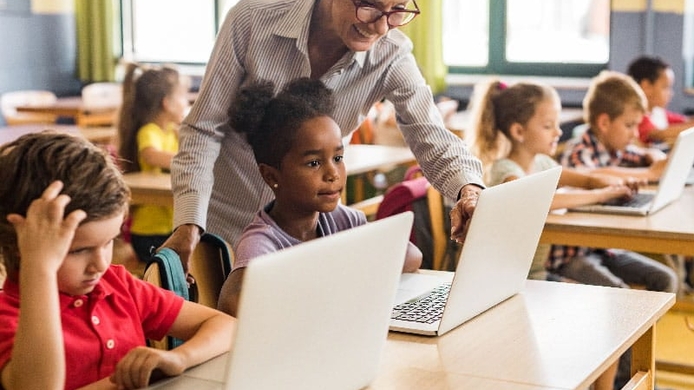Explore our resources for teaching and education degrees and learn about career options that fit your future.

In today’s technology-driven world, teachers are always looking for new ways to enhance the student experience. With so many advanced tools available now, it can be difficult to know where to start. We have put together a list of some of the best websites, platforms, and apps that teachers can utilize today to improve and enhance the classroom.
Organization & Collaboration Tools
1. Google Workspace
Google Workspace, formerly Google for Education, has been and remains a free foundational platform offering real-time collaboration with Docs, Sheets, Slides, and more, enabling streamlined organization, document sharing, and calendar management. This cloud-based platform enables seamless access to lesson plans and resources across any device, ensuring flexibility and anytime access. Integration with Google Classroom for classroom management and the addition of AI-powered features and enhanced privacy controls make it especially relevant in classrooms today.
2. Microsoft OneNote
Microsoft OneNote seamlessly integrates with Microsoft 365 (e.g. Word, Teams, Outlook, etc.) to provide students and teachers with integrated tools that promote real-time co-authoring and collaboration and unmatched student accessibility. Key benefits include organizing notes, sharing content, and engaging in group assignments, projects, or feedback all in one place — especially important as many school districts deploy Microsoft platforms as standard.
3. Canvas by Instructure
Canvas is a leading Learning Management System (LMS) for K-12 classrooms, featuring expanded integrations with educational apps, analytics, video conferencing, and adaptive learning paths — providing a hub for digital content. The company also offers higher-level tools that include assessment technology and analytics to pull everything together. The system integrates with all your favorite apps for a custom experience. Teachers can create a "Free-for-Teacher" account which allows you to create content, personalize learning with master paths, use the mobile app suite and integrate third-party applications.
4. Kami
Kami has emerged as a leading tool for document annotation, organization, and collaborative learning — particularly for integrating PDFs and multimedia content. Kami’s interactive features and integration with Google Classroom and Canvas make it ideal for teachers needing flexible document management with audio, video, and markup tools. Kami also enables students to respond with text, drawings, voice notes, and video, supporting differentiated learning.
Assessment & Data Tools
5. Kahoot!
Kahoot! is an industry leader for game-based formative assessment tools, offering expanded capabilities for polls, quizzes, and team competitions. Students play a fast-paced, multiple-choice game using their devices — the app then generates a detailed report of wrong and right answers from each student, providing an instant, easy-to-use assessment tool. This real-time feedback allows teachers to quickly identify learning and progress gaps. You can create your own “Kahoot,” or choose a ready-to-use template. The platform also integrates with virtual/hybrid classrooms and supports self-paced homework assignments (challenges).
6. Nearpod
This robust tool is ideal for creating interactive lessons, quizzes, VR field trips, and formative assessments. Students join with a code, and all activity is teacher-paced or student-paced for differentiated instruction in all K-12 grades. By gathering real-time assessment data, teachers can adjust instruction immediately based on student needs. Nearpod integrates with Google Classroom and other LMS platforms for seamless assignment distribution.
Engagement & Accessibility Tools
7. Flip
Flip (formerly Flipgrid) is a video-based discussion platform that gives each student a voice in class, making participation accessible and engaging for all learners, including students who are remote or require alternative ways to respond and participate. Teachers can moderate, comment, and give video or typed feedback. It is also useful for family engagement, student portfolios, and global classroom connections.
8. Read&Write
Read&Write is a literacy support toolbar designed to provide text-to-speech, word prediction, picture dictionaries, and annotation tools suitable for a wide range of abilities, including and supporting individualized education plans (IEP) and students with learning differences. It also offers translation and picture dictionaries for English learners and early readers. Read&Write integrates with browsers and major classroom platforms for universal accessibility.
9. Edpuzzle
Edpuzzle is an interactive video platform designed specifically for teachers and K-12 classrooms, allowing educators to turn any video into a dynamic, personalized lesson. It empowers teachers to embed questions, audio notes, and quizzes directly into videos sourced from sites like YouTube or created by the educator themselves. Edpuzzle can be used for both synchronous and asynchronous instruction, helping engage students, hold them accountable, and provide instant feedback on their understanding. It includes progress monitoring and gradebook tools to see who’s watched which parts of each video, ideal for individual learning, or hybrid and remote environments.
AI & Advanced Teaching Tool
10. MagicSchool.ai
MagicSchool.ai is a comprehensive AI-powered platform designed for teachers, helping them save substantial planning time and personalize classroom experiences. It automates daily teaching tasks such as lesson planning, resource creation, feedback, and accommodation suggestions, letting teachers focus more on students and less on repetitive work. This tool instantly generates instructional guides, quizzes, and writing prompts based on grade, subject, and learning objectives and can adapt output for diverse learners with built-in IEP and differentiation tools.
Like many other tools today, MagicSchool.ai seamlessly integrates with popular learning management systems (LMS) for assignment distribution. It also offers an AI “co-teacher” that recommends personalized interventions and supports teacher growth. Best of all? It promotes responsible use of AI by providing student-appropriate filters and ethical guardrails.
11. Google NotebookLM
This AI-powered research and organization tool brings together source material, automates note-taking, and generates summaries, highlights, and study aids directly from classroom content. Google NotebookLM helps teachers and students combat information overload by synthesizing resources and making learning more personalized and efficient.
It can also create instant assessments and reading comprehension questions for different learning levels. Real-time sharing and co-editing of “notebooks” among teachers and students is great for collaborative projects. With the recent integration with Google Classroom, teachers can assign “notebooks” or interactive AI study partners directly to students.
12. ChatGPT (OpenAI)
There are many great AI tools for teachers, ChatGPT is another example. It offers natural language, conversational AI for both teachers and students, streamlining lesson planning, material generation, differentiated instruction, and student engagement. Its ability to generate, revise, and translate content makes it valuable across curriculum areas, particularly for personalized learning and efficiency. Things you can do include automating lesson planning, quiz/test creation, and material rewrites for multiple reading levels or languages to include all learners.
ChatGPT can deliver personalized tutoring, writing assistance, and instant explanations for students — available 24/7 — and can help generate creative assignments (like writing prompts, scripts, and project ideas) and supports brainstorming in class. Due to lack of security parameters, teachers should guide students in its ethical use and check for academic integrity in assignments.
Teacher Community & Social Media Tools
13. Facebook
Facebook remains the dominant platform for school communities and parent engagement in the social media sphere. Its broad reach makes it ideal for sharing news, events, and key school updates. Official school pages, private parent groups, and PTA accounts can be used in a variety of ways to connect and communicate with families and the greater community. Photo sharing, event invites, live Q&A sessions, and alumni networking are just a few ways Facebook makes it simple to share information. Due to familiarity among parents and staff, Facebook is a trusted resource for school-to-home communication.
14. YouTube
YouTube can be used as a tool for increased student engagement. It is the primary channel for long-form video content, such as event recordings, virtual tours, and educational series. It is great for sharing lectures, performances, tutorials, and school promotional videos and can host curriculum-related playlists and student-created content. The platform supports accessibility with captions, transcripts, and translation tools.
15. TikTok
TikTok is another video tool that can be used for student engagement and creative school branding. It is a better resource for relatable video content that reaches students directly and helps humanize school staff. It features trends, challenges, and “student takeovers” to showcase daily life and achievements. The content is highly shareable among student communities, and is especially useful for highlighting reels, recruitment campaigns, and creative learning snippets.
Classroom Technology Tools: A Guide to Integration
With so many exciting options, it can feel overwhelming to effectively integrate these tools and platforms into your classroom. Here is a simple guide to help you get started:
- Identify the specific needs of your students, subject, lesson, or class dynamics and match them with compatible technology tools for educators and their features.
- Pick tools that already align with your current teaching goals — such as Google Workspace for collaboration, Edpuzzle for interactive video lessons, or Kahoot! for assessments.
- Gradually introduce new tools, rotating them based on lesson objectives: use interactive video or quizzes for review days, collaborative platforms for group projects, and AI-powered assistants like MagicSchool.ai or ChatGPT when you want to personalize learning or save time in planning.
- Provide clear structure and expectations when introducing a new tool, model best practices for students, and use built-in analytics like those offered by Nearpod or Edpuzzle to adapt and refine your instruction based on real student feedback.
Once you figure out a process, it can be helpful to regularly reflect on which tools are supporting engagement, which might be rotated out, and how to differentiate instruction for diverse learners. Encourage students to become familiar with multiple platforms, allowing for variety, and invite feedback on which tech enhances their learning experience.
In education today, technology tools are no longer optional — they are essential for preparing students for the demands of the modern world. These platforms foster active engagement, accessibility, personalized learning, and real-time feedback that equip students not just with content knowledge but with communication, collaboration, and digital literacy skills that are vital for their future success.
Check out our blog “ChatGPT for Educators” to learn more about incorporating this technology and other AI tools into your learning environments.








